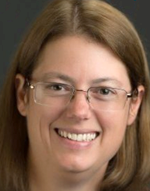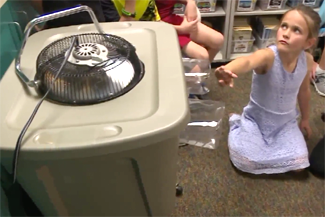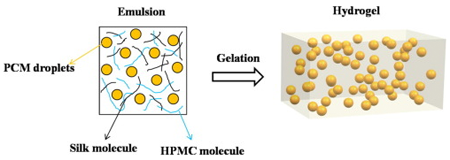 The Phase Change Matters e-mail newsletter is a weekly summary of the latest news and research on phase change materials and thermal energy storage. To subscribe, visit www.puretemp.com/subscribe. For more frequent updates, follow @puretemp on Twitter or visit the Phase Change Matters blog, www.puretemp.com/pcmatters.
The Phase Change Matters e-mail newsletter is a weekly summary of the latest news and research on phase change materials and thermal energy storage. To subscribe, visit www.puretemp.com/subscribe. For more frequent updates, follow @puretemp on Twitter or visit the Phase Change Matters blog, www.puretemp.com/pcmatters.
MANUFACTURING
Microtek joins RAL Quality Association PCM
Microtek Laboratories, which purchased BASF‘s Micronal line of microencapsulated phase change material earlier this year, has joined the RAL Quality Association PCM, effective Jan. 1, 2018.
 The Dayton, Ohio, company will assume BASF’s membership in the association, which was established in 2004 to develop standards for the phase change material industry. Microtek plans to attend the association’s next meeting, set for Oct. 17 in Düsseldorf, Germany.
The Dayton, Ohio, company will assume BASF’s membership in the association, which was established in 2004 to develop standards for the phase change material industry. Microtek plans to attend the association’s next meeting, set for Oct. 17 in Düsseldorf, Germany.
“Microtek is pleased to become a member of the RAL Quality Association,” said Tim Riazzi, right, Microtek president. “The Association has accomplished a great deal in bringing PCM technology into alignment with various markets. We would also like to express our appreciation for all BASF has done in the past to contribute to the association and help make it what it is today.”
PATENTS
Micro environmental control system
U.S. patent application 20170276408 (applicant Hussein Ezzat Khalifa, Manlius, N.Y.):
“A micro environmental control system that can remove or add 30W from or to the near range personal microenvironment of a user. For cooling, the μX uses a micro vapor compression system during the un-occupied period to freeze a phase-change-material in a thermal storage module. A fan then moves air over the phase-change-material to deliver cooled air. Heating is delivered by a small electric heater integrated into a condensing unit. The resulting system is inexpensive to build and uses a limited amount of energy.”
Evaporator and refrigerator using the evaporator
U.S. patent application 20170276419 (applicant Samsung Electronics Co. Ltd., Gyeonggi-do, Republic of Korea):
“Disclosed are an evaporator, a refrigerator using the evaporator, and a method for controlling the refrigerator. The evaporator includes a refrigerant evaporation unit in which a flow passage where a refrigerant evaporates is formed, and a phase change material (PCM) accommodation unit that is coupled to the refrigerant evaporation unit and accommodates the PCM whose phase is changed according to latent heat absorbed by the refrigerant, wherein the PCM is brought into direct contact with an outer surface of the refrigerant evaporation unit inside the PCM accommodation unit.”
IN BRIEF
 • Dr. Amy Fleischer, chairman of the mechanical engineering department at Villanova University, will give a presentation next month on the effect of carbon-based networks on enhanced energy storage materials. The presentation is set for Oct. 20 at Oregon State University in Corvallis. From the abstract: “Many common PCMs have high energy storage capacity but low thermal conductivity so much work has been done to improve their system performance by using nanoscale inclusions intended to increase the effective thermal conductivity. The work presented here shows that in certain situations, not only does the thermal conductivity increase, but also the latent heat. This effect is explored to understand the physical phenomena in order to harness the effect for advanced materials design.”
• Dr. Amy Fleischer, chairman of the mechanical engineering department at Villanova University, will give a presentation next month on the effect of carbon-based networks on enhanced energy storage materials. The presentation is set for Oct. 20 at Oregon State University in Corvallis. From the abstract: “Many common PCMs have high energy storage capacity but low thermal conductivity so much work has been done to improve their system performance by using nanoscale inclusions intended to increase the effective thermal conductivity. The work presented here shows that in certain situations, not only does the thermal conductivity increase, but also the latent heat. This effect is explored to understand the physical phenomena in order to harness the effect for advanced materials design.”
• Registration is open for “Ambient Temperature Profiles,” Sonoco ThermoSafe‘s next webinar on temperature assurance packaging. It will be held on Oct. 10 at 11 a.m. Eastern time. Iftekhar Ahmed, R&D team leader at ThermoSafe, and Bernard McGarvey, senior engineering advisor at Eli Lilly & Co., will lead the session. Participants will learn about “standard ambient profiles, vendor and published profiles and how others even develop their own profiles using empirical temperature data and distribution steps.”
• New from Grand View Research: “Thermal Energy Storage Market Analysis By Type, 2014-2025“
• New from QYResearch: “Global Thermal Energy Storage (TES) Market 2017 Share, Size, Forecast 2022“
• Scientists working on the International Energy Agency’s Solar Heating and Cooling Programme Task 53 have compared the cost, efficiency and adaptability of solar cooling storage solutions. The researchers examined both thermal and electricity storage systems and are now creating guidelines for choosing the most fitting solution to heat and cool buildings. But the group will not, according to solarthermalworld.org, issue a recommendation favoring either storage system. “There are too many unknowns. Apart from technical considerations, you need to look at each country’s legislative framework and feed-in tariffs,” said Elena-Lavinia Niederhäuser, author of the report and director of the Energy Institute at Fribourg’s College of Engineering and Architecture, Switzerland.
 • When a recent heat wave turned his elementary school into a sauna, a resourceful fourth-grader in Michigan built a home-made air conditioner for his classroom, using a plastic tub, an electric fan and bottles filled the world’s cheapest phase change material: water. Abram Barker said he got the idea from YouTube but used a larger base and added towels to insulate the frozen water bottles and soak up condensation.
• When a recent heat wave turned his elementary school into a sauna, a resourceful fourth-grader in Michigan built a home-made air conditioner for his classroom, using a plastic tub, an electric fan and bottles filled the world’s cheapest phase change material: water. Abram Barker said he got the idea from YouTube but used a larger base and added towels to insulate the frozen water bottles and soak up condensation.
• Registration is open for “Cone Calorimeter: Quantifying Easily Flammability & Heat Release Rate,” an online course offered by SpecialChem.com. The instructor is T. Richard Hull, professor of chemistry and fire science at the University of Central Lancashire. The course will be held at 10 a.m. EST on Oct. 12. The cost is $307 for three participants on a single connection.
• The Phase Change Materials Industry Association, which will hold its inaugural meeting in Boston Oct. 5, has been registered as a corporation in the United States. Its official name: the Phase Change Materials Industry Association of North America Inc. Representatives of more than a dozen companies are scheduled to attend next week’s meeting.
RESEARCH ROUNDUP
For our full list of recent academic research, see puretemp.com/academic. Here are highlights from the past week:
From Materials Letters:
• Temperature buffering capacity of silk hydrogel: A useful packaging material
• Preparation and Characterization of Cross-linked Polyurethane Shell Microencapsulated Phase Change Materials by Interfacial Polymerization
From Energy and Buildings:
• Performance study on different location of double layers SSPCM wallboard in office building
• Facile Preparation of Porous Plaster Board Containing Phase Change Capsules Using Gel Template
• Preparation and properties of capric-stearic acid/White Carbon Black composite for thermal storage in building envelope
• Environmental and spatial assessment for the ecodesign of a cladding system with embedded Phase Change Materials
From Solar Energy Materials and Solar Cells:
• Novel shapeable phase change material (PCM) composites for thermal energy storage (TES) applications
From Renewable and Sustainable Energy Reviews:
• Novel approaches and recent developments on potential applications of phase change materials in solar energy
From Energy Conversion and Management:
• Heat transfer enhancement of phase change materials by fins under simultaneous charging and discharging
From 13th International Conference on Heat Transfer, Fluid Mechanics and Thermodynamics:
• Multiphase transport phenomena in composite phase change materials for thermal energy storage
From International Journal of Heat and Mass Transfer:
• Study of thermal conductive enhancement mechanism and selection criteria of carbon-additive for composite phase change materials
From Polymer Testing:
• Natural aging of shape stabilized phase change materials based on paraffin wax
NETWORKING
Connect with PCM experts and industry leaders on LinkedIn
More than 1,100 people have joined a LinkedIn group devoted to the discussion of phase change material and thermal energy storage. The Phase Change Matters group is an interactive complement to the award-winning blog and newsletter of the same name.
 A recent post about Tempassist, a wall decor system that uses PCM to maintain comfortable temperatures and reduce energy costs, generated a lively discussion on LinkedIn. Larson-Juhl is bringing the product to market under a partnership/licensing agreement with Phase Change Energy Solutions. PCES says the system offers a 50 percent reduction in HVAC on/off cycles.
A recent post about Tempassist, a wall decor system that uses PCM to maintain comfortable temperatures and reduce energy costs, generated a lively discussion on LinkedIn. Larson-Juhl is bringing the product to market under a partnership/licensing agreement with Phase Change Energy Solutions. PCES says the system offers a 50 percent reduction in HVAC on/off cycles.
Mike Berry, managing director at Datum Phase Change Ltd., expressed skepticism: “50% reduction in HVAC? I don’t think so. Come on, guys, be realistic. You’re going to give PCM a bad name.”
John Curley of Conex Bänninger jumped in: “Have to agree with Mike on this. 50% would be a big claim for an active PCM system but in this passive form its bordering on ridiculous. Is the ventilation tied in to take advantage of the diurnal, how much area is covered, what control is available if any etc. Some facts and figures would be good.”
Doug Doolen, PCES’ Tempassist expert, responded: “Actually 50% reduction in HVAC ON/OFF cycles.”
Walter van Kampen of Autarkis: “I doubt it, especially since it’s a biobased passive PCM system. Please get your story sorted out. We at Autarkis have done the most PCM climate buildings up to now in the world. But we give a straight and solid advice on what we can and can’t do. I don’t care about non-competitors. But this is not the PCM story you should be telling with your product.”
Doug’s response: “Tempassist powered by BioPCM has summary test results posted at www.tempassist.com/casestudies.html. These findings are consistent with scale model testing, hot box testing, room to room with control and full scale building testing that have been ongoing since 2015. Reduction in HVAC cycling leads directly to a reduction in HVAC energy (25-35%) and is consistent with our experience in other BioPCM building applications.”
Another commenter, based in China, expressed enthusiasm about the product and asked: “Where can I buy it?” Doug directed him to www.tempassist.com/connect.html.